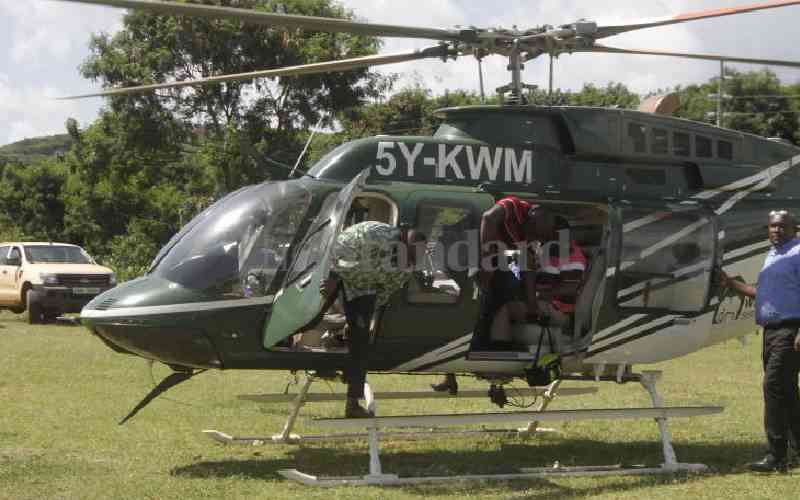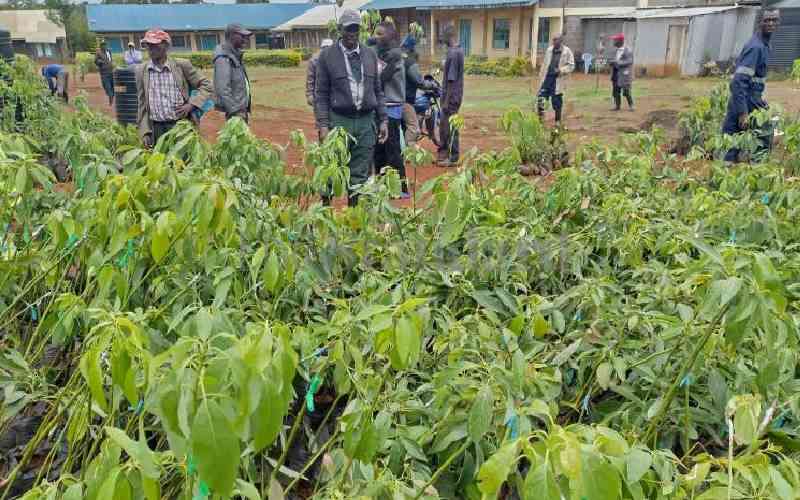 |
|
Richard Ambani (right) with his elder brother Christopher Ndunga assemble the home-made plane at their home in Shibiriri Village, Kakamega County.[Photo: Chrispen Sechere] |
Kakamega, Kenya: They move up and down, passion written all over their faces, their energy and determination quite something to be behold. Their working chemistry baffles many. In the small village of Jamindas, Kakamega town, they are popularly referred to as “the pilots of Kakamega”. Never mind none of them has ever boarded a plane.
From cheap improvised materials, the duo has managed to make a battery-powered aircraft, which is radar-controlled and propelled by an electric mortar.
The inspirational story of Christopher Ndunga and Richard Ambani is one filled with sheer determination and a thirst for excellence. The two orphaned brothers found their bond in a common passion.
“I have always had a passion to become a pilot. Whenever I see airplanes in the skies, my dream of one day flying them becomes even clearer and that is where I have drawn the motivation behind this innovation,” said 28-year-old Ndunga, a former student at Kaimosi Secondary School.
His younger brother, Ambani, 17, is currently a Class Seven pupil at Matungu Primary School.
Their education levels aside, they are passionately pursuing their dream.
Valid dream
“We used to talk about aeroplanes at home and everyone would boast of owning one whenever it flew above us. Slowly we found the connection and we decided to chase the dream,” narrates Ambani of their humble beginning.
The aircraft is made from plastic material, metal sheets and pieces of paper. The metals are well shaped and pieced together, ensuring measurements are clearly taken into context.
Since they are yet to come up with a mechanism to control movement in the air, they are careful not to trigger a take-off.
“We requested the authorities at the Kakamega Airstrip and we even tried to fly our aircraft. We used their runway and the plane gathered momentum, it flew about three metres high and since then, we are careful not to fly it here at home for safety reasons,” notes Ndunga.
In Kenya, it is required that any object flying into airspace must be licensed but at the moment, there is no aviation law to regulate unmanned objects.
In August last year, Chris Ghalily, an aviation student with a dream to fly the first Kenyan made drone faced a myriad of challenges especially with the Kenya Civil Aviation Authority (KCAA), who refused to license his innovation.
“This is a great innovation that can open doors for a lot of research. Should this be taken up by institutions of research, it can be a great breakthrough in this field of study,” observes Veronica Kiluva, a researcher at Masinde Muliro University of Science and Technology (MMUST).
MMUST Deputy Vice Chancellor in charge of Research, Extension and Innovation Egara Kabaji says the main predicament facing research in Kenya is lack of funding.
Stay informed. Subscribe to our newsletter
“This country has a lot of potential with great minds but limited funds have always hampered meaningful research,” said Prof Kabaji.
Kabaji added that local universities have failed to take their rightful place in research to incubate brilliant ideas among youth.
“Unlike in developed countries, we lack structures and mechanisms to assist talents. Worse still, the assumption that nothing good can come from this part of the continent appears to have been augmented and with this kind of environment, it explains why we are witnessing exodus of talent to the West,” he said.
Indeed, even neighbours are fascinated by the two young lads innovation and those who have been watching them are rooting for their success.
“I have been watching them every morning make their aircraft and it gives me pleasure that these young men are chasing a dream. If they can get someone to help them expand on their endeavours perhaps through training, these are stars in the making,” observed Mama Anyanga, a neighbour.
In order to sustain their lives, Ndunga works as a taxi driver in Kakamega town and it is from the meagre proceeds that they buy materials to improve their plane.
“I earn roughly between Sh300 and Sh1,000 a day. This is all we have to survive from but we always find ways to save a little for buying materials, it is not easy,” asserts Ndunga.
Aeronautical engineer
Youngster Ambani is yet to finish primary school but finds Physics textbooks used at secondary level very useful.
“My favourite subject is Science. I love machines and sometime I find myself borrowing books from friends to study Physics. I want to end as an aeronautical engineer, which is where my heart lies,” says Ambani.
Charles Nyambuga, a communications expert at Maseno University offers that the real intentions of the 8-4-4 system went down the pan the moment technical institutions were upgraded into universities.
“None of the 8-4-4 goals have been effectively tackled. When the system was introduced, it was supposed to advance innovation, entrepreneurship among other goals but this has not been achieved,” said Dr Nyambuga.
And as jobs become increasingly elusive in Kenya, the hope of Ndunga and Ambani is that their innovation will play a role in making their lives betters.
 The Standard Group Plc is a
multi-media organization with investments in media platforms spanning newspaper
print operations, television, radio broadcasting, digital and online services. The
Standard Group is recognized as a leading multi-media house in Kenya with a key
influence in matters of national and international interest.
The Standard Group Plc is a
multi-media organization with investments in media platforms spanning newspaper
print operations, television, radio broadcasting, digital and online services. The
Standard Group is recognized as a leading multi-media house in Kenya with a key
influence in matters of national and international interest.
 The Standard Group Plc is a
multi-media organization with investments in media platforms spanning newspaper
print operations, television, radio broadcasting, digital and online services. The
Standard Group is recognized as a leading multi-media house in Kenya with a key
influence in matters of national and international interest.
The Standard Group Plc is a
multi-media organization with investments in media platforms spanning newspaper
print operations, television, radio broadcasting, digital and online services. The
Standard Group is recognized as a leading multi-media house in Kenya with a key
influence in matters of national and international interest.









